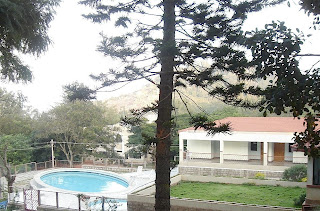
SriKalahasti temple is located 36 km away from Tirupathi in Chittoor district of Andhra Pradhesh, India.
The Kalahasti temple is dedicated to Kalahasteswara worshiped as Vayu Lingam. The Vayu Lingam, represents the element wind out of the five elements of Agni, Vaayu, Aakasam, Jalam and Prithvi. This temple is renowned for performing Sarpadosha (Rahu Ketu) Nivaarana Pooja. The inner temple is constructed around 5th century and the outer temple was constructed in the 12th Century.
There is a lamp burning inside the inner sanctum that constantly flickers despite the lack of air movement inside. The vayu-linga can be seen moving despite the doors being closed. The sanctum has no windows, the lamp flames keep moving despite no air movement. The linga is white and is considered Swayambhu - self-manifested.
Kalahasti is surrounded by two hills. The Durgamba temple on the north hill and the shrine of Kannabeswara on the south hill, in memory of the Sage Kannappa, who offered an eye to the Lord. There is also a temple dedicated to Subramanya on one of the hills. A river flowing in the north washes the foot of the temple. The main linga remains untouched by human hands, even the priests do not touch it. Abhishek (bathing) is done by pouring a mixture of water, milk, camphor and panchamrita. Sandal paste, flowers and the sacred thread are offered to the utsava-murti, and not the main linga. It has an enormous, ancient gopuram over the main gate, which is 36.5 metres (120 feet) high and the entire temple is carved out from the side of the hill. King Krishnadeva Raya built this temple in1516. The temple is very ornate with elaborately designed pillars, altars, etc.
According to ancient Tamil sources Sri Kalahasti has been known as the ‘Kailas of the South’ for slightly more than two thousand years and the small river on whose banks it sits, the ‘Ganges of the South.’ Kailas is perhaps India’s most revered spiritual symbol. It is the abode of Shiva, from whose head, according to legend, the Ganges is said to flow. Shiva, ‘that which is auspicious at all places, times and in all circumstances’ is a symbol of the Self and the Ganges flowing from his head represents the spiritualized or awakened mind. A mind sourced in Spirit is a river of immeasurable power and life-giving goodness. The claim that Kalahasti is the ‘Kailas of the South’ simply means that the small hill near the temple is to be taken as the spiritual equivalent of the Himalayan Kailas. Likewise, the small river flowing in a northerly direction beside the temple is to be taken as the mighty Ganges.
The God Dakshinamurthy whose name means ‘the one facing south’ and whose idol (murthy) is installed in the Kalahasti Temple, sits in the North and faces south. East often represents the dawning of wisdom, the sun being another common Self symbol.

SriKalahasti got its name because in days of yore a spider (sri), serpent (kala) and elephant (hasti) elephant worshipped Shiva with great devotion. A spider lived in the inner sanctum and worshipped the Lord by weaving elaborate temples and images of Shiva. One day a breeze came up and caused the altar fire to destroy the spider’s offerings. It became angry and was about to gulp down the flame, (realize the Self) endangering its (ego’s) life. Appreciative of its devotion, Shiva appeared and granted the spider a boon. The spider requested moksha, release from the cycle of births and deaths. Accordingly it became one with Shiva, the Self.

A cobra worshipped Lord Shiva by offering rare gems, pearls and rubies that it brought from Nagaland, a mythical place where Nagas (serpents) dwell. Serpents are one of India’s most visible symbols of the spiritual power of the Self. The spiritual power of the Self, called Kundalini, the latent electricity of Consciousness, is hidden in the dark recesses of the unconscious like a snake hidden deep within the earth. After the snake had worshipped, an elephant, fresh from its purifying bath in the nearby river, came to worship. In preparation it sprayed the altar with water from its trunk, scattering the gems. It then proceeded to decorate the altar with leaves from a holy tree. When the cobra returned it was angered to see its offerings disrespected and replaced by mere leaves. So it replaced the leaves with gems. This charade repeated itself every day until the cobra became fed up and decided to punish whomever was destroying its offerings. When the elephant returned to worship with its leaves the cobra slithered up its trunk and injected its venom. In agony the elephant dashed its head on the stone altar in an attempt to kill the snake. The snake fell out of the trunk and died from its wounds and the elephant succumbed to the poison. Understanding that both had sacrificed their lives for the sake of their love of the Lord, Shiva resurrected them, gave them liberation and took them into his own body. At the foot of the linga one can see a spider, two elephant tusks and a five-headed (the five elements) serpent to remind the devotee of these acts of supreme devotion.












